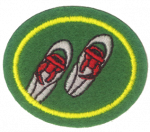AY Honors/Snowshoeing/Answer Key/es
| Senderismo con raquetas de nieve | ||
|---|---|---|
| Asociación General
|
Destreza: 1 Año de introducción: 2010 |
|
Requisitos
|
La especialidad de Senderismo con raquetas de nieve es un componente de la Maestría Recreación. |
1
Aerobic/running
An aerobic/running snowshoe is intended for use by runners who would otherwise not be able to train in their sport when there is snow on the ground.
2
2a
2b
2c
3
3a
3b
3c
3d
4
Mantener el calor
Adventist Youth Honors Answer Book/Maintaining body warmth/es
La hipotermia
Adventist Youth Honors Answer Book/First aid/Hypothermia/es
5
5a
5b
5c
5d
5e
6
The first thing to do when you fall is to check that you are not injured. Then roll onto your stomach, raise yourself up on all fours, pushing with your forearm until you can shift your weight to your knees. Assume a kneeling position. Then while steadying yourself with trekking poles (if you are using them), raise one knee and get the snowshoe beneath yourself. Then as you stand on that leg, get the other shoe into its proper position.
7
When traditional wooden shoes were still popular, it was common to buy the bindings separately (much like downhill skis), and many wooden shoes are still sold this way). They were commonly called "H" bindings, since they consisted of a strap around the heel crossing a strap around the toe and one at the instep, forming a rough version of that letter.
A series of straps, usually three, are used to fasten the foot to the snowshoe. Some styles of binding use a cup for the toe. It is important that a user be able to manipulate these straps easily, as removing or securing the foot often must be done outdoors in cold weather with bare hands, exposing him or her to the possibility of frostbite. When putting on snowshoes, left is distinguished from right by which way the loose ends of the binding straps point: always outward, to avoid stepping on them repeatedly.
In 1994, Bill Torres and a younger associate developed the step-in binding, designed to make it easier for snowshoers wearing hard-shelled plastic boots (serious mountaineers) to change from snowshoes to crampons and back again as needed.
Snowshoe manufacturers each have their own designs for bindings, and each design fastens differently. Because of this, it is not possible to give generic instructions for fastening them. You will have to consult the instructions that come with your shoes in order to fasten them correctly.
When selecting snowshoes, the bindings are one of the most important features to consider. They should be easy to put on, and easy to get off. If they are not, you will be much less likely to use them. Also remember that the bindings will likely require adjustments while you are out on the trail. Under these conditions, the straps are likely to be stiff with ice, and your fingers are likely to be cold.
Some experienced snowshoers & advise against bindings that are based on straps that make two passes through a buckle and rely on friction to stay put.
8
An excellent place to begin snowshoeing is on a golf course. The course will obviously not be used by golfers when it is covered with snow. Golf courses provide open spaces and gentle slopes. Other options are parks, hiking trails, and cross-country skiing trails.
Be sure to record your trip as soon as possible upon your return. It is easy to forget details. Measure the snow depth with a stick. Is the snow light and fluffy, or is it wet and packed?
To maximize your chances of seeing wild animals, minimize your noise. Look for animal tracks and listen for birds. Bring a camera and see if you can capture the beauty of the snow-laden landscape.
9
Cleanse me with hyssop, and I will be clean;
wash me, and I will be whiter than snow.
The color white represents purity. In this verse, the psalmist compares sinlessness with the whiteness of snow. It is easy to see flecks of dirt in snow, and it is likewise easy to tell that snow is clean and pure. When we are cleansed of sin by Jesus, we are completely purified.
For other metaphors, try to think of things in nature that are pure or white. Here are some ideas:
- Rain water
- Wool
- Flour
- Pure grape juice (wine has leavening in it, and leaven is a symbol of sin).
References
- ↑ Snowshoeing, A Trailside Guide by Larry Olmsted
- Categoría: Tiene imagen de insignia
- Adventist Youth Honors Answer Book/Honors/es
- Adventist Youth Honors Answer Book/es
- Adventist Youth Honors Answer Book/Skill Level 1/es
- Categoría: Libro de respuestas de especialidades JA/Especialidades introducidas en 2010
- Adventist Youth Honors Answer Book/General Conference/es
- Adventist Youth Honors Answer Book/Recreation/es
- Adventist Youth Honors Answer Book/Recreation/Primary/es
- Adventist Youth Honors Answer Book/Stage 0/es
- Adventist Youth Honors Answer Book/Recreation Master Award/es
- Adventist Youth Honors Answer Book

